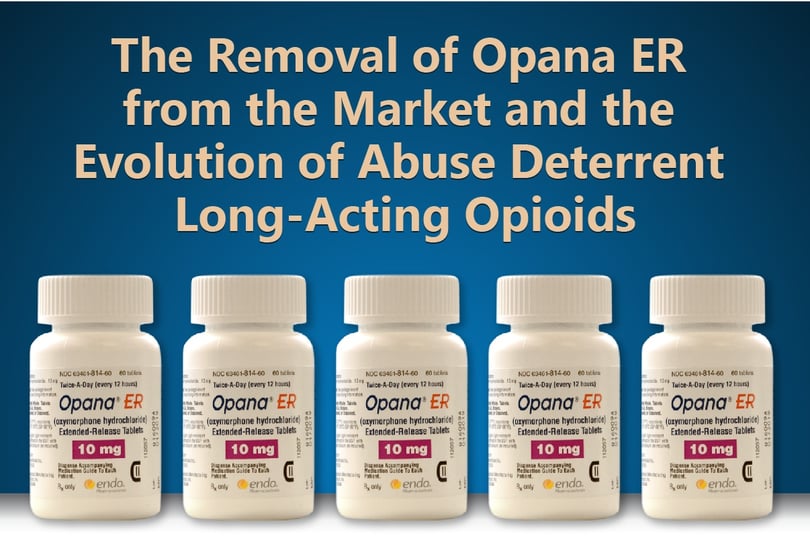The Evolution of Abuse Deterrent Long-Acting Opioids

The United States is currently facing an epidemic of opioid abuse and overdoses. The Center for Disease Control (CDC) cites over 183,000 deaths from 1999-2015 due to opioid overdoses. This epidemic, also referred to as the opioid crisis, stems from the overprescribing of opioids, recreational misuse, and the gateway of prescription opioids to more illicit drug use, such as heroin. How did we get to this point and what is being done to prevent misuse of opioids? To better understand the exponential growth of opioid use, we must look at the evolution of long-acting opioids and how these drugs have shaped current prescribing trends and medication approval rates.
In the mid 1990’s a new, long-acting opioid, OxyContin, soared onto the market to control chronic pain. This medication offered a slow release of the active ingredient, oxycodone, into the body over a 12-hour period.
Doctors began to prescribe OxyContin at an alarming rate. As more prescriptions were written and OxyContin tablets were in circulation, problems with misuse of the medication were in the spotlight. Although the drug was coated to release medication slowly in the body, the coating did not prevent users from intentionally misusing the medication for recreational purposes. The tablet could be cut, chewed, crushed to snort nasally or crushed and dissolved to inject it into the body. This misuse of OxyContin causes a rapid release of the powerful drug into the body, giving the user a dangerous high.
The ability and high frequency of misuse of OxyContin raised red flags for the Food and Drug Administration (FDA). In 2010, a new formulation of OxyContin was released into the market and it came with an FDA-approved label showing the tablet had, “abuse deterrent properties.” It was the first long-acting opioid to have such label. The abuse deterrent properties included a coating that makes the tablet more difficult to cut or chew and a gel matrix that formed if the tablet was crushed or dissolved, making inhalation or injection difficult.
The reformulation of OxyContin shaped how prescribers viewed long-acting opioids and how the FDA approved new applications for long-acting opioids. In 2013, a long-acting hydrocodone capsule called Zohydro was introduced to the market. Zohydro saw nationwide backlash as the product had no abuse deterrent properties. The nationwide attention drove some states to take legal action, threatening to ban the product or issuing warnings to prescribers and users of the medication. The makers of Zohydro did reformulate the drug in 2015 to a new BeadTek technology, which causes the beads containing the active drug to form a viscous gel when crushed or dissolved, ultimately making the drug harder to misuse.
OxyContin and Zohydro are not the only two long-acting opioids to of had problems with the FDA. In 2017, the FDA requested that Endo, the makers of Opana ER, remove the product from the market. Opana ER was approved in 2006 without an abuse deterrent label and then reformulated in 2011 with some properties to prevent misuse. However, the FDA did not approve an abuse deterrent label for their reformulation. The FDA stated that the reformulated product was being misused as an injection and the sharing of needles from injecting the drug had been linked to an HIV outbreak in Indiana. In late summer of 2017, Endo complied with the request and Opana ER was voluntarily taken off of the market.
As of 2017, the FDA lists 10 long- acting, abuse deterrent opioids that come with abuse deterrent labeling. The drug companies have developed different methods to make long-acting opioids harder to be manipulated. Some companies use physical barriers making the tablets hard to cut, crush, chew and manipulate further. Others use an opioid antagonist component that causes the user to feel withdrawal symptoms or block the euphoric effects of an opioid when the drug is manipulated.
One of these recently approved long-acting opioids is a form of extended release oxycodone called Xtampza ER. This opioid has received recognition from the FDA for its proprietary abuse deterrent technology called DETERx. Studies have shown that even if chewed or crushed, the DETERx microbeads containing the active drug stay intact with no rapid release of medication. Xtampza ER is the only long-acting opioid with an abuse deterrent label that is not required to warn against chewing or crushing.
The long-acting opioids currently on the market are effective in treating pain for patients when prescribed and used appropriately. The innovative abuse deterrent technology development by the pharmaceutical industry and the FDA’s handling of Opana ER has shown that there is a serious response to the opioid crisis, and an intent to keep safe and effective opioids on the market.
Other Posts You Might Be Interested In
Subscribe to email updates
Stay up-to-date on what's happening at this blog and get additional content about the benefits of subscribing.


